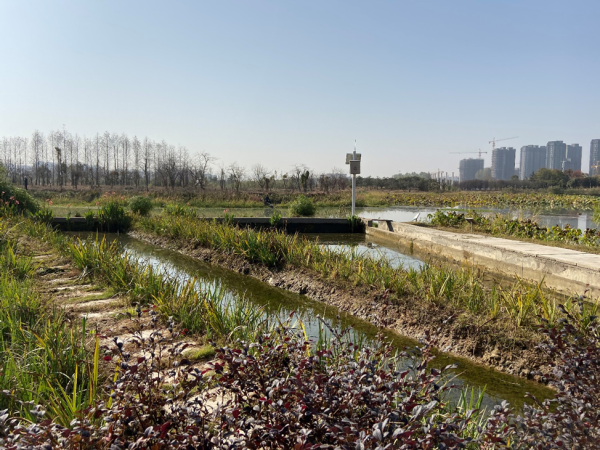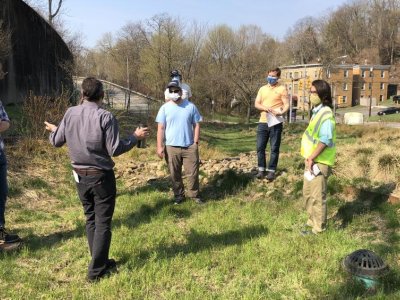Stormwater runoff is one of the leading environmental problems for many countries. The traditional management approach uses so-called “gray infrastructure,” such as pipes and channels, to discharge stormwater runoff to local waterways quickly. This approach often faces financial challenges in constructing, maintaining, and updating treatment systems to address increased flooding and stormwater problems caused by increasing urban imperviousness and changing climate. Thus, a relatively new way to achieve long-term stormwater control is to combine green stormwater infrastructure (GSI) with gray infrastructure to manage stormwater. GSI is a decentralized system that involves many natural elements such as soils, plants, and stones to intercept, infiltrate, and store excessive stormwater runoff. Examples include rain gardens, bioswales, green roofs, and constructed wetlands. These natural systems allow excessive stormwater runoff to be treated at the source area immediately, preventing stormwater runoff from directly entering the drainage systems and avoiding overflow problems in severe storm events.
In addition to stormwater control, GSI is also known to provide many other ecosystem benefits. For example, it can increase aesthetic value, add urban greenery, provide educational and recreational opportunities, regulate microclimate, and improve air quality. To achieve optimal performance in delivering these ecosystem benefits, urban managers and designers need to involve individuals and communities in the design, planning, and management of GSI. Understanding people’s perceptions, such as their general awareness of stormwater problems, knowledge, attitudes, and level of support in accepting GSI in public and private areas, are crucial to increasing people’s participation in urban stormwater management. Moreover, people’s perceptions of ecosystem benefits can also inform the ecosystem benefit provision plan and the design of GSI that better serves public preference.
In China, climate change and urbanization have caused severe flooding and stormwater issues. Thus, a national environmental program called the Sponge City Development was initiated, where the central government-sponsored thirty pilot cities to test GSI in managing stormwater problems. Since 2015, large numbers of GSIs such as rain gardens, constructed wetlands, sunken green spaces, and tree planters have been adopted or are underway in various public and private settings throughout the country. They have rapidly become a prominent feature in China’s urban landscape. To understand people’s perceptions of GSI and the extent to which the implementation of GSI delivers multiple ecosystem benefits, we conducted public surveys in the fall of 2019 in four Chinese sponge pilot cities, Pingxiang, Chizhou, Zhenjiang, and Jiaxing. We also conducted in-depth interviews with local sponge program managers, governmental officials, and designers about the status of public participation and GSI benefit provision planning. All four cities are located in the same subtropical monsoon climatic region in southeastern China, with ample precipitation and abundant water resources, and a complex human-water interface created by networks of rivers, lakes, and wetlands. The rapidly increasing imperviousness and outdated drainage system design standards have brought enormous challenges to their stormwater management programs. Each city had a unique combination of water problems, ranging from flash and torrential flooding to non-point source pollution.

We conducted intercept surveys in multiple neighborhoods, public parks, and streets with GSI installed in the selected cities during 2015 and 2018. Of the 607 people who completed our surveys, 74% of respondents experienced flooding issues. They were unfamiliar with GSI and held strong trust with sponge agencies. The respondents showed more concern about stormwater impacts on their quality of life than the water environment, rating the less-intended aesthetic and health values as the best-perceived benefits. In contrast, the experts spoke more positively about the environmental benefits while indicating the inadequacy of public participation. Moreover, factors including people’s past flooding experience, familiarity with GSI, stormwater concern, institutional trust, and age significantly affected the public’s GSI benefit perception. The differences in perceptions between sponge professionals and the general public indicate the need to incorporate public views into urban GSI design and benefit provision planning.
The case of GSI in China’s Sponge city development offers broad implications for environmental governance and expert-public relationships in an era of rapid social, technological, and environmental change. Refining policies and regulations to incorporate social goals, bringing the public into the SCD process, and building up the GSI industry’s capacity in planning, design, construction, and maintenance are critical to enhancing GSI benefits provision. Adopting the co-benefits approach will be essential to utilizing GSI as a place-making tool to create more sustainable and livable communities.
More details about this research can be found in the published article: https://doi.org/10.1007/s00267-021-01565-9
This article was originally on Medium (https://medium.com/@psuwaterstudentgroup/have-people-perceived-ecosystem-benefits-provided-by-green-stormwater-infrastructure-de1318dc90ca) and was republished with permission.





